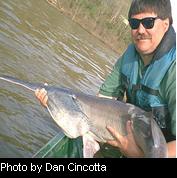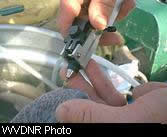

|
The Ohio: A River in Transition By Chris O'Bara The mighty Ohio River has played a major role in the development of commerce in the United States. Historically, the river was the major navigational avenue for westward expansion, serving as the starting point for the Lewis and Clark Expedition. Since the early 1880s, humans have made numerous attempts to “tame” the Ohio River through navigational improvements and the construction of locks and dams along its 1,000-mile course. In West Virginia, the Ohio River forms the western border with Ohio. The river enters West Virginia near Chester in Hancock County and flows southwestward for 272 mil What most of us don't realize is that the Ohio River provides some of the most diverse recreational fishing opportunities in the eastern United States. At least 159 fish species have been reported living in the river, of which 25 are considered sportfish . In West Virginia, anglers can fish for sauger , walleye and hybrid striped bass at the locks and dams, or seek largemouth and smallmouth bass in the many coves and embayments . All was not always good on the Ohio River, however. Poor water quality and sedimentation in the first half of the 20 th century degraded the river to the point that several fish species no longer lived in the river. Once abundant mussel populations declined because of restrictions in water flow, reducing the supply of food and oxygen flowing over the mussels. In addition, the link between fish species and mussels, which use fish as hosts for their larval stages, had been disrupted. Locks and dams had blocked upstream migration for several large fish species like paddlefish and sturgeon. Sauger and walleye, important sport fishes, were also affected by degraded water quality, loss of spawning habitat and migration blockage. Passage of federal water quality laws in the 1970s resulted in improved water quality. Cleaner water has enabled species like the skipjack herring, paddlefish and shovelnose sturgeon to once again inhabit the Ohio River. This improvement has now opened large sections of the Ohio for many fish species to expand their distribution and increase in numbers. So, the question is what is the West Virginia Division of Natural Resources Wildlife Resources Section and other agencies doing to help this amazing recovery. The current “big” issue is fish passage through the locks and dam complexes. The DNR, other Ohio River state fish and wildlife agencies and the U.S. Army Corps of Engineers (COE) are currently addressing this issue. In the summer of 2001, these agencies began a three-year study to address fish passage questions and develop new methods to aid fish in their upstream migration. The COE is funding this study because they operate the locks and dams and can potentially alter their operations of these structures. State agencies are involved because they are entrusted with the management of the fishery resources. The study consists of several parts conducted throughout the 1,000-mile-long Ohio River. First, fish species such as sauger , walleye and white bass are being tagged with visible tags to assess movement patterns. Using electrofishing equipment, West Virginia DNR biologists have collected fish at the Robert C. Byrd , Willow Island, Pike Island and New Cumberland tailwaters and have tagged over 2,500 individuals. Anglers can help by reporting fish they catch with tags to the DNR District VI office in Parkersburg (304-420-4550). In addition, biologists are implanting coded, tiny wire tags into paddlefish so they can determine their movements. West Virginia anglers can also help by reporting any paddlefish they accidentally catch. In the Kentucky section of the Ohio River, biologists are also working with commercial fishermen to recover paddlefish and shovelnose sturgeon. WV DNR and COE biologists are cooperatively monitoring fish passage using several Radio transmitters are also being inserted into fish so biologists can monitor fish movement as they actually move. This exciting activity will allow biologists to track fish in “real-time” to determine where certain species actually live. Another aspect of the study which Ohio River anglers will experience firsthand is a survey of tailwater anglers. Creel clerks are asking fishermen questions about how and why they fish, and the number of fish they catch. In West Virginia, clerks are stationed at the R.C. Byrd , Willow Island, Pike Island and New Cumberland tailwaters . In addition, these creel clerks are actively involved with both tagging and recovering tags from sauger , walleye, white bass and paddlefish. Outcomes of this study should directly benefit all Ohio River anglers, as well as the river resources. By determining movement patterns, biologists and dam operators can enhance fish movement providing greater numbers of catchable fish. Creel surveys will benefit anglers through an increased understanding of their concerns by biologists. The net result of this research will be to improve Ohio River fisheries through a more focused and coordinated management approach by state and federal agencies. The Ohio River, a historic jewel of Middle America, is again along the road to recovery. We may not see the shallow riffle zones where millions of fish once spawned, or be awed by waterfalls, but through increased knowledge of the river and its fish and mussel species, and incorporating this knowledge into operations, we can continue to restore this remarkable river. Chris O'Bara is the DNR Ohio River fisheries biologist stationed in Parkersburg . |
 es before leaving the state near Kenova in Wayne County. Major historic and population centers along the river include Wheeling, New Martinsville, Sisterville , St. Mary's, Parkersburg , Point Pleasant and Huntington. Seven locks and dam complexes are currently within the West Virginia section providing increased navigation opportunities for both commercial and recreational users.
es before leaving the state near Kenova in Wayne County. Major historic and population centers along the river include Wheeling, New Martinsville, Sisterville , St. Mary's, Parkersburg , Point Pleasant and Huntington. Seven locks and dam complexes are currently within the West Virginia section providing increased navigation opportunities for both commercial and recreational users.  techniques. A comparative study is currently underway at the Winfield Locks and Dam on the Kanawha River and the Robert C. Byrd Locks and Dam on the Ohio River to determine how fish move through locks and/or dams. Biologists insert tags similar to bar codes used at grocery stores into fish. Using a hand-held scanner, biologists can later determine where and when the fish were tagged and the operational condition of the locks and or dams when these fish migrated.
techniques. A comparative study is currently underway at the Winfield Locks and Dam on the Kanawha River and the Robert C. Byrd Locks and Dam on the Ohio River to determine how fish move through locks and/or dams. Biologists insert tags similar to bar codes used at grocery stores into fish. Using a hand-held scanner, biologists can later determine where and when the fish were tagged and the operational condition of the locks and or dams when these fish migrated.